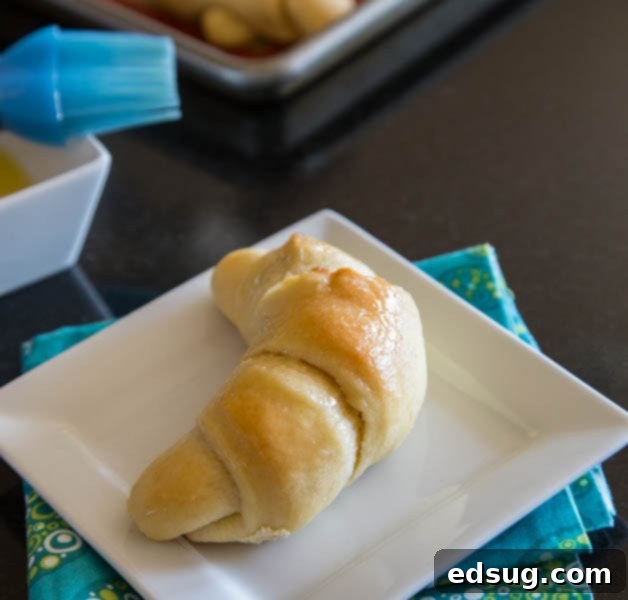Flaky, Buttery, and Irresistible: The Ultimate Guide to Homemade Crescent Rolls
There’s an undeniable magic to fresh bread, especially when it’s warm from the oven, filling your kitchen with an intoxicating aroma. For many, fresh bread is the ultimate companion to a comforting bowl of soup, a hearty stew, or a spicy chili on a cold evening. While store-bought, canned crescent rolls offer convenience, nothing truly compares to the rich flavor, tender texture, and golden-brown perfection of a batch of homemade crescent rolls. These aren’t just any rolls; they are soft, incredibly buttery, and boast a delightful flakiness that elevates any meal into a special occasion.
The allure of light and fluffy bread is something truly special. If you’re anything like me, a life rich in pasta, bread, and various carbohydrates sounds like pure happiness. Add some decadent brownies to the mix, and you’ve got a recipe for culinary bliss. That’s why these homemade crescent rolls consistently rank high on my list of favorite baked goods. They transform an ordinary dinner into an extraordinary dining experience, reminding us that some of the best things in life are made with love and a little patience in our own kitchens.
Many home bakers find the idea of working with yeast intimidating. However, with a clear understanding of the process and a few key tips, baking with yeast becomes an enjoyable and rewarding experience. Forget your fears of flat, dense bread! Mastering yeast allows you to create incredibly delicious fresh bread, like these Honey Butter Dinner Rolls or our spectacular crescent rolls, anytime you desire. It just takes a willingness to get into the kitchen and try!
Essential Tips for Successful Yeast Baking
Baking with yeast doesn’t have to be a daunting task. By paying attention to these crucial details, you’ll be well on your way to consistently perfect, airy, and flavorful bread every time.
- Temperature of Your Liquid is Key: This is arguably the most critical factor when working with yeast. Your water or milk needs to be warm, but never hot. The ideal temperature range is typically between 105°F and 115°F (40°C-46°C). If the liquid is too hot, it will kill the yeast, rendering it inactive, and your dough will not rise. Conversely, if the liquid is too cold, the yeast will not activate or grow properly, resulting in a similar lack of rise. Use a thermometer for accuracy, especially when you’re starting out.
- Ensure Your Yeast is Fresh and Active: Good quality, fresh yeast is non-negotiable for successful bread baking. Always check the expiration date on your yeast package. Expired yeast will not activate, leading to disappointing results. Proper storage is also vital; keeping yeast in an airtight container in the refrigerator or freezer helps prolong its shelf life and potency. If you’re unsure about your yeast’s viability, proof it first: mix a teaspoon of sugar and your yeast in a small amount of warm water (as per recipe instructions). If it becomes foamy and bubbly within 5-10 minutes, it’s active and ready to use. If not, it’s best to discard it and get a fresh batch.
- Kneading is Non-Negotiable: Kneading develops the gluten in your flour, which provides the structure and elasticity necessary for a light, airy crumb. You can knead by hand on a floured surface or use an electric stand mixer fitted with a dough hook. It’s crucial to follow the recipe’s recommended kneading time. Don’t eyeball it! If the recipe calls for 10 minutes, set a timer and knead for the full duration. When I first started baking bread, I often cut this step short, leading to many failed attempts with dense, heavy loaves. Properly kneaded dough will be smooth, elastic, and spring back when lightly poked.
- Allow for Proper Rising (Proofing): Yeast thrives and multiplies in a slightly warm, dark, and humid environment. This “rising” or “proofing” stage is where the magic happens, as the yeast produces carbon dioxide, causing the dough to expand. If your kitchen is cold, especially during winter months, find a warm spot for your dough. This could be near a heat vent, in a slightly warmed (but turned off!) oven, or in a draft-free cupboard. Many modern ovens even have a dedicated “bread proof” setting, which is perfect for this purpose. Cover your dough with a clean kitchen towel or plastic wrap to prevent it from drying out while it rises.
I genuinely believe that few things rival the comforting aroma of fresh bread baking in your oven. It’s a smell that instantly evokes warmth, nostalgia, and the promise of a delicious meal. While Classic Oatmeal Bread is one of my personal favorites for its incredible toast potential the next day, if your experience with crescent rolls has been limited to those convenient tubes from the grocery store, it’s time for a culinary revelation! These homemade crescent rolls are so incredibly good, versatile enough for any meal, and definitely not reserved just for special occasions. They’re a treat you’ll want to enjoy often.
Mastering the Art of Rolling Homemade Crescent Rolls
Achieving that classic crescent shape is simpler than you might think, and it’s a satisfying part of the baking process. Once your dough has completed its first rise and has been divided, you’ll work with each portion to create the perfect foundation for your rolls.
Begin by taking one portion of your dough and rolling it out on a lightly floured surface. Aim for a round circle, approximately 12 inches in diameter. The thickness should be relatively even to ensure uniform baking. Once you have a nicely shaped circle, you can use a sharp knife or, even better, a pizza cutter to divide it. Imagine you’re slicing a pie: cut the circle into 8 equal wedges, starting from the center and radiating outwards. This will give you 8 triangular pieces of dough.
Now comes the fun part: shaping the crescents! Take one of your triangular slices. Starting from the widest end (the outer edge of the circle), begin to tightly roll the dough towards the narrow, pointed center. The key is to roll it snugly, but without tearing the dough. This tight roll helps create those beautiful, flaky layers. As you roll, the natural tapering of the wedge will effortlessly form a perfect crescent shape. Once rolled, gently curve the ends inward slightly, giving it that characteristic “c” shape, before placing it on your prepared baking sheet. Ensure the pointed end is tucked underneath the roll to prevent it from unraveling during baking. Repeat this process for all your dough portions, and you’ll have a tray full of potential golden perfection!
Once they emerge from the oven, glistening and golden, don’t forget the final touch: a generous brush of melted butter. This not only adds an extra layer of rich flavor but also contributes to that irresistible, soft exterior. Pure deliciousness awaits!
Serving Suggestions for Your Golden Rolls
These versatile homemade crescent rolls are much more than just a side dish. While they perfectly complement soups, stews, and chili, their light and buttery nature makes them suitable for a variety of occasions. Serve them alongside a holiday feast, as part of a Sunday brunch spread, or simply as a delightful bread option for a weeknight family dinner. They’re wonderful warm with a smear of extra butter, a drizzle of honey, or your favorite jam. You can even get creative by stuffing them with cheese, herbs, or even a small piece of cooked sausage before baking for a savory treat. For a sweet twist, a sprinkle of cinnamon sugar before rolling can transform them into a delicious breakfast pastry.
Storing and Reheating Your Homemade Delights
Should you be lucky enough to have any leftover crescent rolls, storing them properly will help maintain their freshness. Once completely cooled, place them in an airtight container or a resealable plastic bag at room temperature for up to 2-3 days. For longer storage, they freeze beautifully! Wrap individual rolls tightly in plastic wrap, then place them in a freezer-safe bag or container for up to 2-3 months.
To reheat, simply warm them in a preheated oven at 300°F (150°C) for about 5-10 minutes, or until heated through. If reheating from frozen, you can often go straight from the freezer to the oven, adding a few extra minutes to the baking time. A quick brush with melted butter before reheating can help restore some of their fresh-baked goodness.
Common Baking Questions and Troubleshooting
Even with the best intentions, baking can sometimes throw a curveball. Here are answers to some common questions and troubleshooting tips for your crescent rolls:
- Why didn’t my dough rise? This is almost always due to inactive yeast. Double-check your yeast’s expiration date and the temperature of your liquid. If your water was too hot, it killed the yeast. If it was too cold, the yeast wouldn’t activate.
- My rolls are dense/tough. What happened? This could be a few things: not enough kneading (gluten didn’t develop), too much flour (dough was too stiff), or insufficient rising time (yeast didn’t produce enough gas). Ensure you measure flour accurately and knead for the full recommended time.
- My rolls are dry. Overbaking is a common culprit. Keep a close eye on your oven and remove the rolls as soon as they are golden brown. Brushing with melted butter immediately after baking also helps keep them moist.
- Can I make these ahead of time? Absolutely! You can prepare the dough up to the shaping stage, cover the shaped rolls, and refrigerate them overnight. Let them come to room temperature for about 30-60 minutes before the second rise and baking. You can also freeze the shaped, unbaked rolls and bake them from frozen (adding extra baking time).
Baking homemade crescent rolls is a truly rewarding experience that fills your home with warmth and delicious aromas. With a little practice and these detailed tips, you’ll soon be baking perfect, tender, and flaky crescent rolls that will impress everyone at your table. Embrace the process, and enjoy the unparalleled taste of freshly baked bread!
I created a fun group on Facebook, and I would love for you to join us! It’s a place where you can share YOUR favorite recipes, ask questions, and see what’s new at Dinners, Dishes and Desserts (so that you never miss a new recipe)! If you’d like to check it out, you can request to join HERE.
Be sure to follow me on Instagram and tag #dinnersdishes so I can see all the wonderful DINNERS, DISHES, AND DESSERTS recipes YOU make!
Connect with Dinners, Dishes, and Desserts!
Be sure to follow me on my social media, so you never miss a post!
Facebook | Twitter | Pinterest | Instagram


Crescent Rolls
Pin Recipe
Rate Recipe
Print Recipe
Equipment
-
Kitchen Aid Stand Mixer
Ingredients
- 1 1/4 oz package active dry yeast
- 1/4 cup warm water, (110 to 115 degrees)
- 1/2 cup + 1 Tablespoon sugar, divided
- 3/4 cup warm milk, (110 to 115 degrees)
- 3 large eggs, beaten
- 1/2 cup butter, softened
- 1 teaspoon salt
- 5 to 5-1/2 cups all-purpose flour
- Melted butter
Instructions
-
In the bowl of an electric mixer (or a large mixing bowl if kneading by hand), combine the active dry yeast and warm water. Add 1 tablespoon of sugar to this mixture. Let it stand for about 5 minutes until it becomes foamy. This indicates your yeast is active and ready to work!
-
Next, add the remaining 1/2 cup of sugar, warm milk, beaten eggs, salt, and softened butter to the yeast mixture. With the mixer on a low speed (or by hand), gradually add enough all-purpose flour to form a stiff, cohesive dough ball. Transfer the dough to a lightly floured surface and knead for 6 to 8 minutes. If the dough is too sticky, add a little more flour, one tablespoon at a time, until it’s smooth and elastic. The dough should spring back when gently poked.
-
Lightly oil a large bowl. Place the kneaded dough in the bowl, turning it once to ensure it’s coated with oil. This prevents the dough from sticking and drying out. Cover the bowl with plastic wrap or a clean kitchen towel and let it rise in a warm, draft-free place for about 90 minutes, or until it has doubled significantly in size.
-
Once the dough has risen, gently punch it down to release the air. Divide the dough into 3 equal parts. Take one part and roll it out on a lightly floured surface into a 12-inch round circle. Using a sharp knife or a pizza cutter, cut the circle into 8 equal wedges, similar to slicing a pie.
-
Take each wedge and, starting from the wide end, tightly roll it towards the pointed tip. Gently curve the rolled dough to form the classic crescent shape. Place the shaped rolls on a baking sheet lined with parchment paper, ensuring the pointed end is tucked underneath to secure the shape. Cover the rolls lightly and let them rise for another 30 minutes. This second rise contributes to their light and airy texture.
-
While the rolls are completing their second rise, preheat your oven to 375 degrees Fahrenheit (190°C).
-
Bake the crescent rolls for 10-12 minutes, or until they are beautifully golden brown. As soon as they come out of the oven, brush them generously with melted butter for extra flavor and a beautiful sheen. Serve warm and enjoy!
Notes
Nutrition
Nutrition information is automatically calculated, so should only be used as an approximation.
Additional Info
Like this recipe? Leave a comment below!
